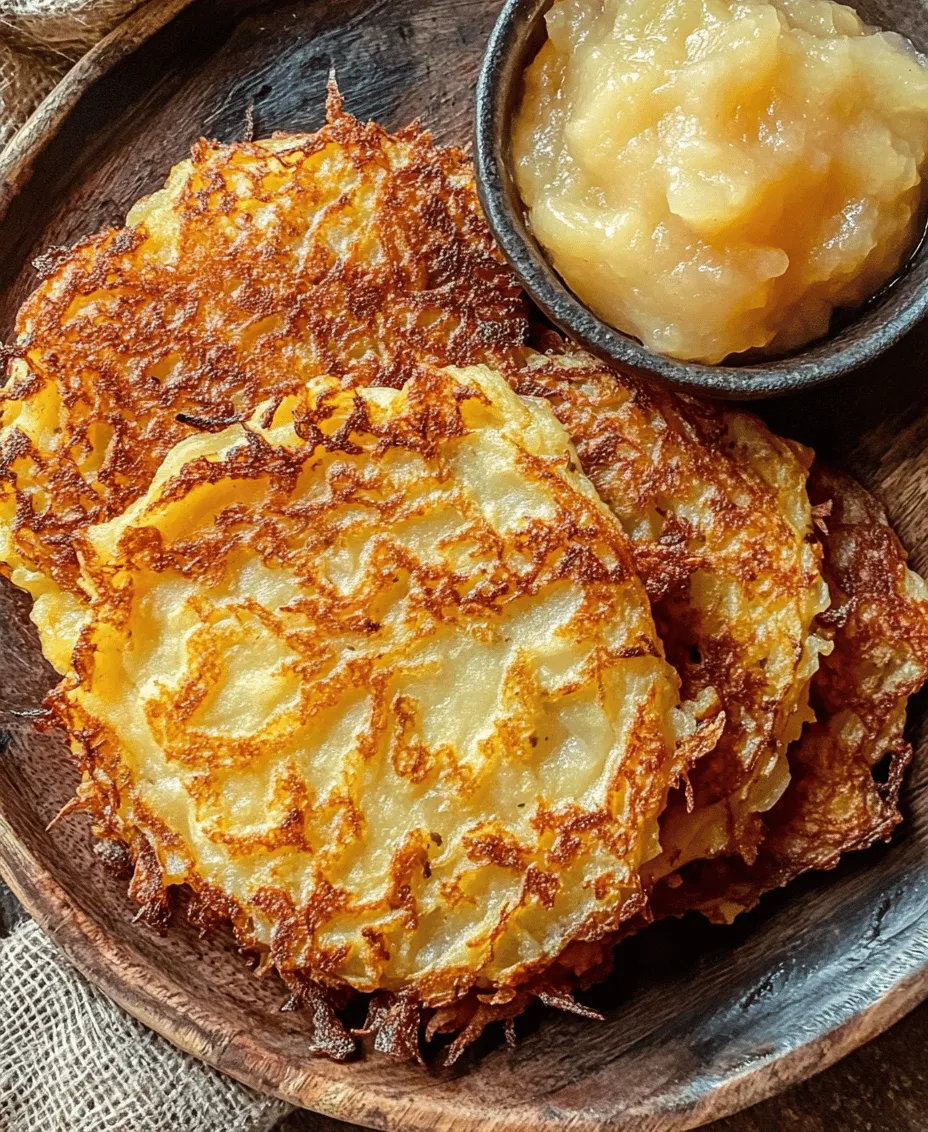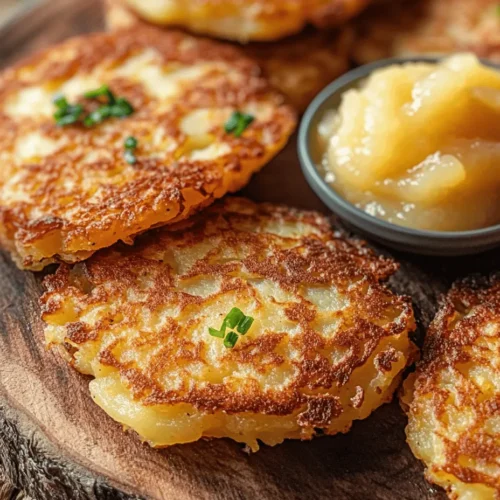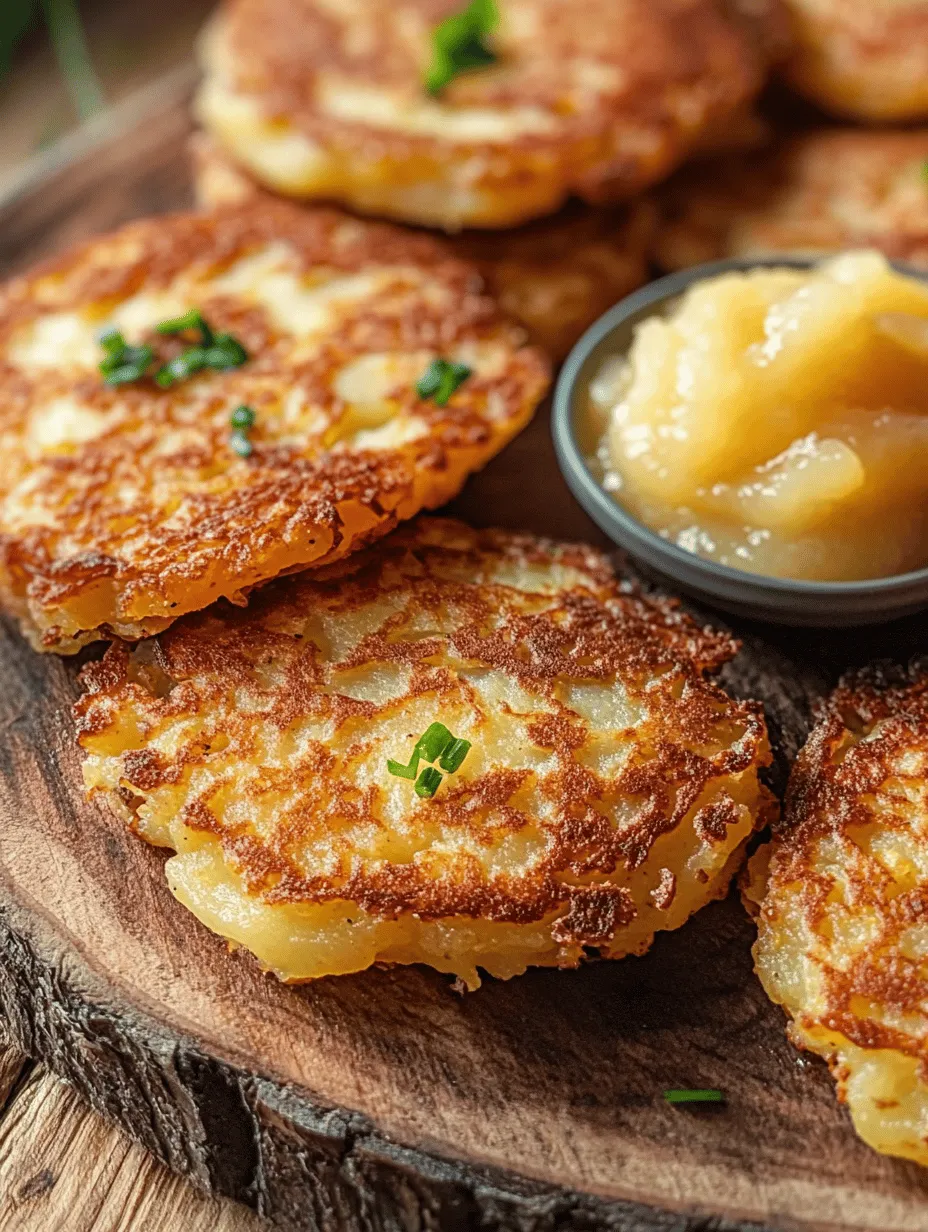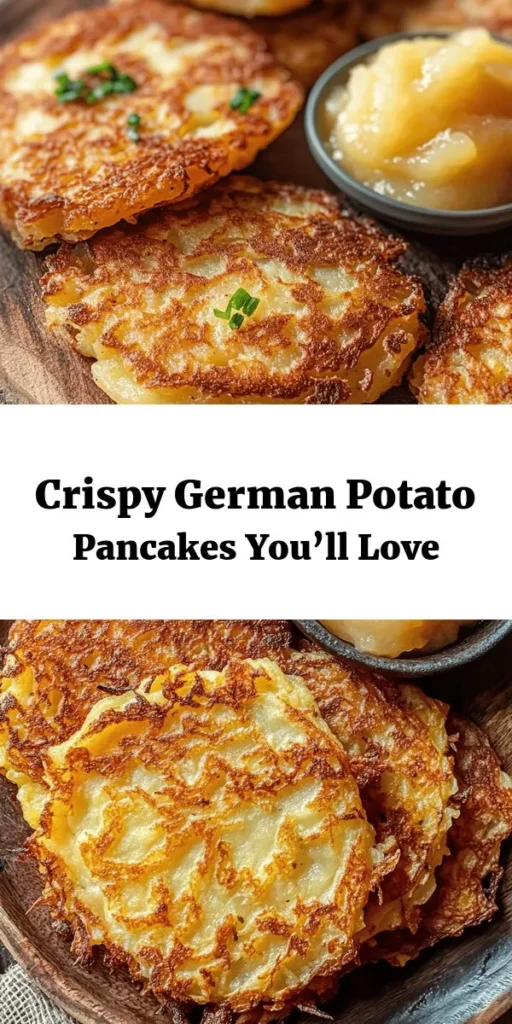Introduction
German potato pancakes, known as Reibekuchen, are more than just a dish; they are a beloved symbol of German culinary heritage. These crispy, flavorful pancakes have been a staple in German kitchens for generations, cherished for their comforting taste and versatility. Whether served as a side dish or a main attraction, Reibekuchen brings a taste of home that resonates with many, evoking memories of family gatherings, festive markets, and hearty meals.
The appeal of crispy potato pancakes extends beyond their taste; they embody the essence of German comfort food. The golden-brown exterior, paired with a soft, tender inside, creates a delightful contrast that is hard to resist. Traditionally enjoyed with applesauce, sour cream, or even smoked salmon, they can easily adapt to various palates and occasions, making them perfect for any meal.
In this article, we will guide you through an authentic recipe for German potato pancakes, allowing you to experience the rich flavors and textures of this traditional dish right in your own kitchen. Prepare to embark on a culinary adventure as we explore the ingredients, preparation process, and cooking techniques that will help you create the perfect crispy Reibekuchen.
Understanding the Ingredients
To make the best German potato pancakes, it’s essential to understand the role of each ingredient. The primary ingredients include:
– Potatoes: The star of the dish, potatoes provide the base flavor and texture. When making potato pancakes, the type of potato you choose greatly affects the outcome. Russet potatoes are often preferred due to their high starch content, which contributes to a light and crispy texture. Alternatively, Yukon Gold potatoes offer a slightly creamier texture and buttery flavor, which can add richness to the pancakes. Experimenting with different varieties can yield interesting results, but for authenticity, russets are the go-to choice.
– Onion: Grated onion not only adds flavor but also moisture to the mixture. It complements the potatoes beautifully, enhancing the overall taste of the pancakes. The right amount of onion is crucial; too much can overpower the potato flavor, while too little may leave the dish bland.
– Eggs: Eggs act as a binding agent, helping to hold the pancake mixture together. They also contribute to the overall moisture and richness of the pancakes, ensuring they have a fluffy interior.
– Flour: A small amount of flour is essential for binding the mixture and providing structure to the pancakes. It absorbs some of the excess moisture from the potatoes, helping to achieve the desired crispy texture. For those looking for gluten-free options, cornstarch or a gluten-free flour blend can be substituted.
– Salt and Seasoning: Salt enhances the flavor of the pancakes, while additional seasonings such as pepper or nutmeg can elevate the taste profile. A dash of salt is essential for bringing out the natural flavors of the ingredients.
Understanding these ingredients and their roles will help you create a balanced and flavorful pancake that captures the essence of this traditional German dish.
Preparation Process
Preparing the potatoes for your Reibekuchen is a critical step that can make or break the final product. Here’s a detailed guide on how to effectively prepare your potatoes:
1. Peeling the Potatoes: Start by peeling the potatoes to remove the skin. This step is essential for achieving a smooth texture. Use a vegetable peeler for efficiency and ensure you remove any blemishes or dark spots.
2. Grating Techniques: Once peeled, the next step is grating the potatoes. You can use a box grater or a food processor for this task. A box grater allows for more control and can create different textures depending on the side you use; the large holes will yield thicker shreds, while the smaller ones will create finer shreds. If you opt for a food processor, use the grating attachment for quick results.
3. Moisture Removal: After grating, it’s crucial to remove excess moisture from the potatoes. This step is vital for achieving the crispiness that Reibekuchen is known for. Place the grated potatoes in a clean kitchen towel or cheesecloth and twist it to extract as much liquid as possible. Alternatively, you can place them in a fine-mesh strainer and press down to drain. This process not only helps in achieving that sought-after crispy texture but also ensures that the pancakes hold their shape during frying.
4. Combining with Onions: Grate the onions using the same method as the potatoes. Combine both grated potatoes and onions in a mixing bowl. The moisture from the onions will help to keep the pancakes flavorful and juicy, but it’s important to drain any excess liquid from the mixture, similar to the potatoes.
Utilizing these preparation techniques will set the foundation for creating delicious and crispy potato pancakes that stay true to their German roots.
Mixing the Perfect Batter
Creating the perfect batter for your German potato pancakes is where the magic happens. Follow these step-by-step instructions to ensure a balanced and flavorful mixture:
1. Combine Ingredients: In a large mixing bowl, combine the drained grated potatoes and onions. Next, crack in the eggs and add them to the mixture. The eggs will help bind the ingredients together and provide a rich flavor.
2. Adding Flour: Gradually sprinkle in the flour while mixing the batter. The amount of flour may vary depending on the moisture content of the potatoes, so start with a small amount and add more as needed. The goal is to create a mixture that holds together but is not overly stiff. If you’re looking for a lighter texture, you can also add a pinch of baking powder at this stage to help the pancakes rise slightly during frying.
3. Seasoning the Batter: Season the batter with salt and any additional spices you desire. A pinch of black pepper can enhance the flavor, while nutmeg adds a warm undertone that pairs beautifully with potatoes. Mix until everything is well combined, but avoid overmixing, as this can lead to dense pancakes.
4. Texture Check: Your batter should have a slightly loose consistency, allowing it to scoop easily but still hold its shape. If it seems too wet, incorporate a bit more flour; if it’s too dry, a small amount of water or additional grated onion can help moisten it.
The balance of flavors and textures is the key to achieving authentic Reibekuchen. The combination of potatoes, onions, and seasonings creates a harmonious blend that will leave your taste buds satisfied.
Cooking Techniques for Perfect Pancakes
Now that your batter is ready, it’s time to master the cooking techniques that will elevate your potato pancakes to perfection. Follow these tips to ensure your Reibekuchen turn out crispy and delicious:
1. Heating the Oil: Start by selecting a heavy-bottomed skillet or frying pan, which will distribute heat evenly. Pour in enough vegetable oil to cover the bottom of the pan; about 1/4 inch deep is ideal. Heat the oil over medium-high heat until it shimmers but does not smoke. To test if the oil is hot enough, drop a small spoonful of batter into the pan; it should sizzle immediately.
2. Forming and Frying the Pancakes: Using a spoon or a small ice cream scoop, carefully drop dollops of batter into the hot oil, spacing them apart to allow for even cooking. Gently flatten each pancake with the back of the spoon to create an even thickness. This ensures they cook evenly and achieve that desired crispy exterior.
3. Maintaining Shape: To prevent the pancakes from sticking to the pan, avoid overcrowding. Fry in batches if necessary, allowing enough space for each pancake to crisp up nicely. Cook for about 3-4 minutes on each side or until they develop a beautiful golden-brown color. Flip them carefully using a spatula to avoid breaking them apart.
4. Draining Excess Oil: Once cooked, transfer the pancakes to a plate lined with paper towels to absorb any excess oil. This step is crucial for keeping them crispy and not greasy.
By mastering these cooking techniques, you will create perfectly crispy German potato pancakes that capture the heart of this traditional dish. With each bite, you’ll experience the comforting flavors of Germany, bringing a piece of this culinary tradition into your home kitchen.
Stay tuned as we continue the journey of making these authentic potato pancakes, diving deeper into serving suggestions, variations, and tips for perfecting your Reibekuchen experience.

Importance of Frying in Batches
When preparing crispy authentic German potato pancakes, it’s crucial to fry the pancakes in batches. Overcrowding the pan can lead to uneven cooking and soggy results. When too many pancakes are added at once, the temperature of the oil drops significantly. This prevents the pancakes from achieving that desirable golden crispiness and can result in the outside cooking too slowly while the insides remain undercooked.
To ensure each pancake has enough room to fry properly, work in small batches, typically 3-4 pancakes at a time, depending on the size of your frying pan. This method allows the oil to maintain its temperature, ensuring that each pancake develops a crispy exterior while cooking through evenly.
Achieving the Ideal Crispiness
Monitoring Cooking Time and Adjusting Heat
The cooking time for potato pancakes generally ranges from 3 to 5 minutes per side, but this can vary based on the thickness of the pancakes and the heat level. It’s essential to start with medium-high heat to get the oil hot enough to create that crispy layer. However, once the pancakes are in the pan, adjust the heat as necessary. If the pancakes are browning too quickly, reduce the heat slightly to allow for even cooking without burning.
Signs of Perfectly Golden Brown Pancakes
A perfectly cooked potato pancake will be a beautiful golden-brown color, with a crispy exterior. When frying, keep an eye on the edges of the pancakes; they should start to look firm and less glossy. Use a spatula to gently lift the pancake and check the bottom. If it’s golden brown, it’s time to flip! Additionally, when the pancakes are flipped, you should hear a satisfying sizzle. This sound is an indicator that they are frying correctly.
Draining Excess Oil Effectively
Once your pancakes are cooked to perfection, it’s vital to drain them effectively to prevent them from becoming greasy. Use tongs or a slotted spatula to remove the pancakes from the frying pan and place them on a plate lined with paper towels. This will absorb any excess oil. For even better results, consider placing a wire rack over a baking sheet to allow the excess oil to drip off while keeping the pancakes crisp.
Serving Suggestions
Traditional Accompaniments
In Germany, potato pancakes are often served with traditional accompaniments such as applesauce and sour cream. The sweetness of applesauce beautifully balances the savory flavors of the pancakes, while sour cream adds a creamy richness that enhances the overall taste. For an authentic experience, serve both on the side, allowing diners to customize their bites.
Creative Serving Ideas
To add a twist to your potato pancakes, consider incorporating fresh herbs or spices into your serving options. Chopped chives or parsley sprinkled on top can add color and a fresh flavor. For a kick, you might try a dollop of horseradish cream or a spicy aioli. Experimenting with flavors can elevate your dish and create a unique dining experience.
Complementary Side Dishes and Beverages
To round out your meal, consider serving your crispy potato pancakes with a side of lightly dressed greens or a simple cucumber salad. These fresh sides can balance the hearty nature of the pancakes. As for beverages, a cold glass of German lager or a refreshing Riesling wine pairs excellently with this dish, enhancing your culinary experience.
Cultural Context and Variations
Potato pancakes, known as “Reibekuchen” or “Kartoffelpuffer” in Germany, have a rich history in German cuisine. Traditionally made during harvest time, these pancakes are a way to utilize fresh potatoes and are often found at fairs and festivals throughout Germany. Regional variations exist, with some areas adding ingredients like onions or herbs to the batter, while others may use different types of potatoes for unique textures and flavors.
Beyond Germany, many cultures have their own interpretations of potato pancakes. In Jewish cuisine, for example, latkes are a popular dish enjoyed during Hanukkah, typically served with applesauce or sour cream. In Eastern European countries, similar recipes exist, showcasing the adaptability of this comforting dish across borders.
During special occasions or festivals in Germany, potato pancakes often take center stage, served alongside other traditional fare. Whether at Christmas markets or outdoor festivals, the aroma of freshly fried potato pancakes fills the air, drawing people in and making them a beloved part of communal celebrations.
Nutritional Information
The main ingredients in crispy potato pancakes include potatoes, eggs, and flour, each contributing to the dish’s overall nutritional profile. Potatoes are a good source of carbohydrates and provide essential vitamins and minerals, including vitamin C and potassium. Eggs add protein and healthy fats, while flour helps bind the ingredients together.
While potato pancakes can be a delicious addition to your meal, it’s important to consider portion control, especially given their rich, fried nature. If you’re looking for healthier modifications, consider baking instead of frying. Baking the pancakes at a high temperature can yield a crisp texture with less oil, making for a lighter version that still satisfies. Alternatively, using sweet potatoes or adding grated vegetables like zucchini can add nutritional value and flavor diversity.
Conclusion
Making crispy authentic German potato pancakes at home is not just about preparing a meal; it’s an opportunity to connect with German culinary traditions and share joyful moments with family and friends. The satisfying crunch and savory flavor of these pancakes create a delightful experience that can bring everyone together around the table.
As you embark on this culinary adventure, remember that every step you take – from selecting the freshest ingredients to frying in batches – contributes to the final dish’s success. So, gather your loved ones, whip up a batch of these delicious potato pancakes, and enjoy a taste of Germany that’s sure to leave lasting memories. Don’t hesitate to share your experience and the joy of making this dish with those around you; after all, food is best enjoyed when it’s shared.



